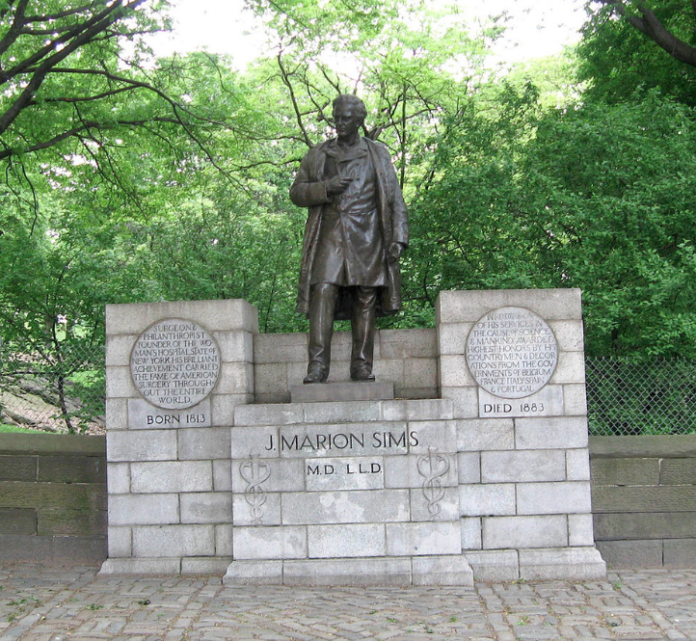
By David T. Z. Mindich, St. Michael’s College
On an October day in 1894, a group of New York City’s leading doctors gathered to unveil a statue in honor of one of the greatest surgeons of his day and the founder of New York’s Women’s Hospital, J. Marion Sims, an Alabama doctor and a man they called “the father of modern gynecology.”
The main speaker that day, George F. Shrady — a towering medical figure himself—spoke of Sims’ many accomplishments as well as his persistence. To perfect one of his innovative surgical techniques, Shrady said, presumably with admiration, Sims had to operate on the same woman 30 times.
The woman, Anarcha, was a slave. And here lies the complicated moral and historical kaleidoscope through which we must view Sims, whose huge statue was relocated in 1934 to 5th Avenue and 103rd Street, just up the street from one of the world’s great hospitals. And as the statue still stands there today in 2014, exactly 80 years since its relocation, it is a good time to ask whether its existence is still appropriate.
Sims’ most lasting contribution to gynecology was in the area of obstetric fistulas, a horrible condition that continues to plague women today. “This is a childbirth injury, often suffered by a teenager in Africa or Asia whose pelvis is not fully grown,” wrote Nicholas Kristof in 2009. “She suffers obstructed labor, has no access to a C-section, and endures internal injuries that leave her incontinent — steadily trickling urine and sometimes feces through her vagina. She stinks. She becomes a pariah.”
Southern roots gave him easy access to black patients
Sims began his extraordinary career as a gynecological innovator by accident in 1845. A surgeon with a growing reputation in Montgomery, Ala., Sims learned about three women, all slaves, who had obstetric fistulas.
Around the time that Sims heard about the slave women, another woman had fallen off a horse, had severe pain in both her pelvis and rectum, and Sims needed to examine her. He discovered that if he positioned her correctly, he could see inside her, giving him hope that fistulas might be repaired.
Along the way, Sims invented the modern speculum and set to work on the slaves. Sims recorded only their first names – Anarcha, Betsey, and Lucy – three teenagers who had had difficult births and developed fistulas; a few other slaves, unnamed, went under Sims’ knife, too. The first operation, on Lucy, was a disaster. Operating without anesthesia, Sims tried to craft a makeshift catheter by inserting a sponge and a piece of string into Lucy’s bladder. “It was a very stupid thing for me to do,” Sims wrote in his autobiography, and the infection and toxic shock amounted to “agony” for Lucy. She almost died.
It was only after dozens of operations – 30 on Anarcha alone – that Sims discovered silver sutures, which were thought to cut down on infections. This was the final addition to make the procedure a success. According to Sims, all three slaves walked out of his makeshift hospital completely cured. How long did the three women endure these operations, all without anesthetics? Four years.

Henry P. Moore/Library of Congress
Can we judge an historical character by today’s standards?
The reappraisal of Sims began in the 1970s and it is no surprise that he is seen today by many as a villain. In Medical Apartheid: The Dark History of Medical Experimentation on Black Americans from Colonial Times to the Present, Harriet A. Washington puts Sims on page 1, the implication being that Sims’ work is the best example ever of white-on-black violence in the name of medicine.
In the last decade, a number of people have pushed back against the view of Sims as a villain. In 2006, L. Lewis Wall, a surgeon writing in the Journal of Medical Ethics, defended Sims’ career. Not only has Wall performed thousands of fistula operations, he has helped raised funds for hospitals that specialize in the ailment.
“In Liberia, I saw a woman who had developed a fistula 35 years earlier,” Wall told Nicholas Kristof. “It turned out to be a tiny injury; it took 20 minutes to repair it. For want of a 20-minute operation, this woman had lived in a pool of urine for 35 years.
Wall pushed back against a number of assertions about Sims, and three are worth revisiting. The first assertion, that Sims didn’t use anesthetics — and should have – is easy to refute, Wall wrote. Ether anesthesia was invented only after Sims began his experiments and he operated on his first white fistula patient three times without anesthesia before curing her.
A second assertion that Wall questioned was that experimentation is inherently immoral. Here, Wall argues that there is a crucial difference between “non-therapeutic and therapeutic” medical experimentation. The former promises no relief, the latter at least holds a chance of a cure. In fact, before Sims began his experiments, fistulas were a guaranteed life sentence of infection, pain, and stinking filth.
But to accept Wall’s defense of Sims’ work based on its therapeutic good, we need to introduce the concept of what philosophers call “moral luck,” a theory often explained by a modern example: Two people drive down separate streets and both run red lights. One driver hits a child and is labeled a murderer. The other driver is lucky: his intersection is empty. How the world perceives these two is dependent on luck. In a similar way, it is only Sims’ luckiness – Anarcha did not die and Sims did stumble upon silver sutures—that created the conditions for him to be celebrated with a statue.
Wall’s third defense of Sims is vexing. Wall argues that the modern critics of Sims are wrong to say that the slaves could not offer their consent.
What constitutes informed consent?
Sims notes that he asked permission, both of the masters, who he promised that no life-threatening experiments would be conducted and of the slaves, who Sims said, “willingly consented.” Wall points out that in Sims’ narrative, the women took turns assisting him in the operations and that the patients themselves had to lie still for the painful operations, a clear sign of consent.
The issue of true consent can never be settled because these women were not free in any legal or practical sense. And the descriptions of consent all came from a single source – Sims himself. One-source stories, particularly ones written by self-interested parties, are always questionable. Sims stands alone on this narrative pedestal.
So should the statue to Sims (actually statues, plural: others are in South Carolina and France) still stand? How do we balance the pain he caused to three slaves with the surgery he helped pioneer, through a mixture of skill, perseverance, timing, and luck?
Perhaps we need a statue, in the shape of a question mark, for all the intellectual, moral, and historical questions that we will never settle.
An even more appropriate testament to the surgical cure of fistulas would be to add three figures to the pedestal, those of Anarcha, Betsey, and Lucy. The bronze eyes of the Sims statue – stentorian, privileged, and aloof – are opaque. The eyes of Anarcha, Betsey, and Lucy, which we can imagine were lined with the creases that deep trials provoke, are forever lost to us. But we know with certainty that the three women, whose bodies played a crucial role in the cure of fistulas, deserve a place on the pedestal, too.
![]()
David T. Z. Mindich does not work for, consult to, own shares in or receive funding from any company or organisation that would benefit from this article, and has no relevant affiliations.
This article was originally published on The Conversation.
Read the original article.




















